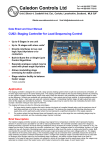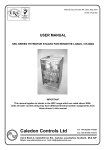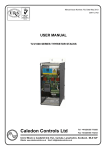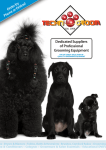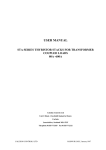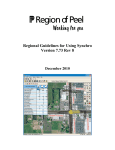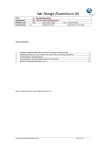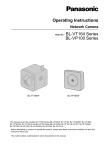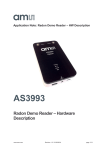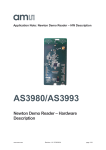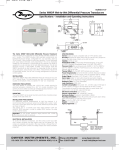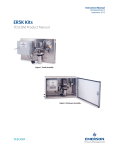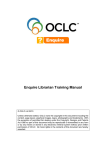Download LSC2 Data Sheet / Manual
Transcript
Caledon Controls Ltd Tel +44 (0)1555 773355 Fax +44 (0)1555 772212 Unit 2 Block 4, Castlehill Ind. Est., Carluke, Lanarkshire, Scotland, ML8 5UF Website www.caledoncontrols.co.uk Email [email protected] Data Sheet and User Manual LSC2 Multi-stage Load Sequencing Controller Revision 4 Up to 6 Stages in one unit Up to 11 stages with slave unit Directly interfaces to low cost logic input thyristor stacks or to contactors Built in Burst fire and Single Cycle Control Algorithms Allows modulating stage oversizing for stable control Stage rotation facility to balance heater usage Galvanically isolated digital inputs and outputs Application The load sequencing controller is designed for use with a large process heating system which is split into several banks of heaters, all of which apply heat input to the same heating load. The controller balances the required heating demand by switching on the number of stages (heater banks) which most nearly match the demand, and modulating one additional stage to make up the difference. Versions are available with combined relay + logic outputs and all logic outputs. A single analogue output is also provided. Relay + logic types are used with contactor stages + 1 modulating thyristor stage; all logic outputs are used when all the stages are controlled by thyristors. The analogue output may be used to drive one modulating thyristor which accepts a standard analogue input signal if preferred. The staging technique provides the following advantages:1 On large electric heating systems the load is broken into banks of a smaller kilowatt rating, and the maximum size of load being switched on or off at any one time is reduced. This reduces the magnitude of switching disturbances on supply lines, and is particularly useful where the total load represents a significant proportion of the supply capacity. 2 On systems where the load demand does not frequently vary over a wide range the non-modulating stages may be contactor controlled, and the modulating stage controlled by a relatively small thyristor stack. Brief Description The new LSC2 controller is based on our successful CU02 controller, and includes additional features which had been incorporated over time in various versions of the CU02 controller. It also offers isolated digital inputs and outputs and additional digital inputs to simplify the provision of ‘special’ versions if required. The LSC2 load sequencing controller accepts an analogue input signal from a temperature controller which represents heating demand. A second input is provided for use with a manual potentiometer. The controller provides outputs for up to 6 stages of heating and there is provision for slaving an additional unit to increase the number of stages to a maximum of 11. The stages may be either 5 relay outputs for use with contactors and 1 logic / analogue output for a modulating thyristor, or 6 logic outputs for use with thyristors. Modulating logic outputs operate in either burst fire mode, or single cycle burst fire mode. Both are intended for use with thyristor controllers which accept a logic input signal and have zero voltage switch on. The stages may either be of the same power rating, or the modulating stage may be oversized which potentially reduces the amount of stage switching required to maintain temperature control. A single 0-5V analogue output is provided which in thyristor / contactor systems may be used with an analogue input thyristor stack for the modulating stage if preferred - this allows a phase angle stack to be used for example. In master / slave applications the analogue output is only available on the master, and is used to drive the input of the slave, and therefore is not available for driving a thyristor stack. In the case of logic input thyristor only systems in which all the stages have the same power rating, the stages may optionally be rotated around the heater banks, which helps to balance the total usage of each heater bank. Specifications Supply voltage 115V or 230V AC 50 / 60 Hz +10% -15% Power consumption 7VA Ambient temperature 0-50OC Approximate Dimensions 120mm high x 200mm wide x 80mm deep (Symmetrical DIN rail mounted) Input signal 0-5V, 0-10V, 1-5V, 2-10V, 0-20mA, 4-20mA, link selectable Auxiliary input signal 0-5V (manual input) may be fed by a 4k7 to 10kΩ potentiometer powered from the unit Non modulating stages: Relay or logic signal (specified at time of ordering). Relays rated 250V AC, 2A. Contactors or slave relays connected to relay outputs must have suppressors fitted around their coils. Logic signal for use with zero voltage switch on thyristors. Galvanically isolated from inputs. Nominally 12V fed via 470 ohm. Output signal Modulating stages: Logic signal for use with zero voltage switch on thyristors. Galvanically isolated from inputs. Nominally 12V fed via 470 ohm. Analogue signal (0-5V). Digital input signal 1 Contact closure or transistor pull up / down (24V logic) switches unit to manual operation. Digital input signals 2 - 4 Contact closure or transistor pull up / down (24V logic). Unallocated - for use with special software versions Indicators LED indicators for power, manual operation selected, manual inputs active, outputs on Safety Standards Complies with European Low Voltage Directive and major international standards EMC Standards Complies with European EMC Directive for operation in an industrial environment Pollution degree 2, Overvoltage category 2, to IEC 664 115 / 230V power input to other ports - double insulated 300V, overvoltage category 3, pollution degree 2 - withstand voltage 3,750V RMS 50Hz Relay outputs to other ports - double insulated 300V, overvoltage category 3, pollution degree 2 - withstand voltage 3,750V RMS 50Hz Between analogue inputs - no isolation Isolation between electrically separated circuits Between any 2 digital inputs - no isolation Between any 2 logic outputs - no isolation Between analogue inputs and logic outputs - withstand voltage 1500V RMS 50Hz Between analogue inputs and digital inputs - withstand voltage 1500V RMS 50Hz Between digital inputs and logic outputs (when digital inputs are fed from a separate supply, eg a plc system) - withstand voltage 1500V RMS 50Hz Ordering Codes There are four options for standard units:LSC2-Relay Stand alone or master controller for use with thyristor / contactor systems (1 logic and 5 relay outputs). LSC2-Logic Stand alone or master controller for use with all thyristor systems (6 logic outputs). LSC2-Relay-Slave Slave controller with relay outputs for use with contactors (5 relay outputs). LSC2-Logic-Slave Slave controller with logic outputs for use with thyristors (5 logic outputs). Special versions of software and minor hardware variations can be made available to enable special sequences or combinations of load types and size. These will have additional references added to the order codes. User Configuration Before putting the controller into service it is important that all the information on preset potentiometers, jumper and DIP switch settings has been read, and appropriate settings chosen. Failure to do so may result in unpredictable operation. Further information on the settings is given in later sections of this manual. Preset Potentiometers P1 P2 P3 Stage switching time delay Ramp time In setup mode sets modulating stage oversize Burst fire cycle time 0.25s to 1 minute (prevents rapid cycling of stages) 0-50s (see section on Ramp Function) 0-100% 0.3s to 20s at 50% duty cycle Jumper and DIP Switch Options Settings Jumpers - Analogue Input Selection Off On JMP1 A 0-5V 0-10V JMP1 B Voltage Input Current Input (connects a 250Ω resistor across the input). Set Jmp 1A off for 20mA span. For signals with 20% zero offset (1-5V, 2-10V, 4-20mA) set DIPswitch 1:7 on. Page 2 DIP Switch 1 1:1 Function Notes Off Single cycle operation On Standard burst fire operation Select the control mode for the modulating stage logic output. Switches 1:2 to 1:4 must be set correctly for the modulating logic output(s) to operate correctly in single cycle mode. The controller power supply must also be wired correctly to match the setting on switch 1:2. The switches must also be set correctly for the logic output to operate correctly in burst fire mode, unless switch 1:6 is on, in which case the setting of these switches, and the power supply connection is immaterial. If the analogue output is used for the modulating stage the setting of these switches, and the power supply connection is immaterial. 1:2: 1:3 1:4 1:5 1:6 1:7 1:8 Off Controller power supply in phase with line to line supply Normal operation On Controller power supply in phase with line to neutral Cannot be used with 2-line thyristor control. Off Load connection for 2-line thyristor control. Load star or delta connected. Only 2 of the 3-phase lines are controlled by thyristors. The third is directly connected to the load. On Load connection for 3 line thyristor control All 3 lines are controlled by thyristors. Off 3-line control, 3-wire load connection (star or delta). On 3-line control, 4-wire star load connection Only operative if 1:3 is on. Must then match the load connection. Off In auto mode the manual input signal has no function On In auto mode the manual input signal sets an upper limit on the input control signal. This enables this input, or a potentiometer connected to this input, to act as a power limit control. Off No function On Modulating logic output signal not synchronised to the mains frequency Off Analogue inputs without offset (0-5V, 0-20mA etc) On Analogue inputs with offset (1-5V , 4-20mA etc) Off Normal operating mode On Setup mode In manual mode the manual input signal controls the output power independent of the auto input control signal. Normally should be off. See switch 1:2 above and section on Controller supply connection and mains synchronisation. In set up mode potentiometer P2 may be used to set the oversize of the modulating stage. See section on Oversizing the modulating stage. DIP Switch 2 Switches 1 to 4 set the number of stages in addition to the modulating stage. For the standard unit (not used as a master) 5 is the maximum valid number. For a master unit 10 is the maximum valid number (5 stages on the master and 5 on the slave). In master / slave systems the slave switches should be set the same as the master. Switch Setting 1 LSB 0 1 0 1 0 1 0 1 0 1 0 1 0 1 0 1 2 0 0 1 1 0 0 1 1 0 0 1 1 0 0 1 1 3 0 0 0 0 1 1 1 1 0 0 0 0 1 1 1 1 4 MSB 0 0 0 0 0 0 0 0 1 1 1 1 1 1 1 1 Number of non modulating stages # 1 2 3 4 5 6 7 8 9 10 10 10 10 10 10 # When switches are set to 0000 the modulating stage output is fed to all stages (master / stand alone controller only), allowing simultaneous modulating of all stages without rewiring (Not suitable for use with relay outputs / contactors!) No function On Stages rotate. Off Stages rotate every 5 hours On Stages rotate every 2 seconds Off All stages rotate Use only with all-thyristor systems. On Only stages 2 to 6 rotate Use when stage 1 is a fixed thyristor modulating stage and stages 2 to 6 are relay stages for use with contactors. Off No function On Progressing modulating stage Off Ramp function always on On Ramp function only operates at power up 6 7 If switch 5 is on and switch 6 is off 7 If switch 5 is off When on the outputs are rotated round the stages. For all thyristor systems switch 6 may be set either off or on as required and switch 7 should be off. For thyristor + contactor systems switch 6 must be off, and switch 7 must be on. Off 5 8 Switch 6 is only applicable when switch 5 is on. The 5 hour rotation may be used to balance out the usage of the heater banks over the long term. The 2 second rotation is used to balance out the heat input when heaters are distributed around a large vessel. It is only suitable for use with single cycle operation (not standard burst fire). When on the modulating stage progresses from one output to the next as each new stage is switched on with increasing input signal. Only applicable for systems in which all stages are thyristor controlled. When off the ramp function operates all the time, for both increasing and decreasing input signal, and serves to slow the operation of the control. When on the ramp function only operates for 30 seconds after first power up, and only for increasing input signal. It serves to limit the rate of application of power on first switch on. See section on ramp function. Page 3 Terminal Function List Terminals marked * have no function on slave units. The 5 outputs available on slave units are on terminals 11 to 15 Terminal Number Function Notes 1 Setpoint input Accepts the setpoint signal (power demand) from a temperature controller. Signal type determined by JMP1 and DIP switch 1:7 setting. 2 0V 0V common for analogue input signals, manual potentiometer and analogue output. 3 +5V Output May be used to energise a 10K potentiometer connected to the manual input. 4* Manual Input Accepts a 0-5V signal when the controller is in manual mode. It is advisable to use a screened cable for the leads to the manual potentiometer, particularly if they are longer than 1 metre, to avoid interference pick up which could cause jitter when switching between stages. The screen should be grounded adjacent to the controller, or to terminal 6 if this is grounded. 5 0V 0V common for analogue input signals, manual potentiometer and analogue output. 6 Functional Earth Not a safety earth. May be connected to chassis to improve EMC noise immunity. For good performance should be connected to the metal chassis adjacent to the controller, using a cable not greater than 250mm (10”) long, and of at least 1mm2 cross section. This may be done easily by fitting a DIN rail mounted earth terminal adjacent to the controller, assuming the chassis is unpainted. 7* Analogue output 0-5V signal which represents the output value of the modulating stage, or is used to drive the slave controller in master / slave operation. 8 0V 0V common for analogue input signals, manual potentiometer and analogue output. 9* Stage 1 Logic Output - Stage 1 output is always a logic output for driving a thyristor stack, and in thyristor / contactor systems is always the modulating stage. Logic outputs are the collectors of NPN pull down transistors. These outputs are therefore connected to the negative side of the logic input on the thyristor trigger. The common positive for these signals is on terminals 21 and 22. (The emitters of transistor logic outputs are commoned in the controller and connected to terminals 18 and 19). 10 No connection Unused terminal to maintain creepage and clearance distance between electrically separated circuits 11 Stage 2 Logic - / Relay output The type of output must be chosen at the time of ordering. 12 Stage 3 Logic - / Relay output 13 Stage 4 Logic - / Relay output 14 Stage 5 Logic - / Relay output 15 Stage 6 Logic - / Relay output 16 Relay Common Common for outputs 2-6 when these are specified as relay outputs. 17 No connection Unused terminal to maintain creepage and clearance distance between electrically separated circuits 18 19 20 21 22 Relay outputs are normally open contacts. One side of all the relay contacts is commoned and brought out to terminal 16. Contactors or slave relays operated by these relay outputs must have suppressors fitted. Logic outputs are the collectors of NPN pull down transistors. These outputs are therefore connected to the negative side of the logic input on the thyristor trigger. The common positive for these signals is on terminals 21 and 22. (The emitters of these transistor outputs are commoned in the controller and connected to terminals 18 and 19). Aux power supply 0V No connection Aux power supply +12V The auxiliary power supply is an unregulated 12V power supply which is galvanically isolated from the analogue inputs and the main controller power supply. It is used to power the logic outputs, and may optionally be used to power the digital inputs, in which case they will not be isolated from the logic outputs. 23 Common for digital inputs 24* Digital input 1; Auto / manual select. Manual when activated (LED on). The digital inputs are opto-coupled, and galvanically isolated from the analogue inputs and logic outputs. They may be driven by any signal between 5V and 24V DC- typically the 24V transistor outputs from a plc, applied between terminal 23 and the relevant input. The common (terminal 23) may be either positive or negative with respect to the input, so either pull up or pull down plc outputs can be used. To activate by volt free contacts the auxiliary power supply may be used to power the inputs. Link terminal 23 to terminal 22 or 21 and connect the contact between terminal 18 or 19 (which becomes the common for all inputs) and the relevant input terminal. The input is active when the contact is closed. Using the same power supply as the logic outputs loses the galvanic isolation between digital inputs and logic outputs. 25 Digital input 2 26 Digital input 3 27 Digital input 4 28 Supply Live Either 115V +10% -15%, or 230V +10% -15%, 50 or 60 Hz. Voltage is selected by jumper assembly immediately above terminals 28 to 30 29 No connection Do not make any connection to this terminal. 30 Supply Neutral Page 4 Safety and Regulatory Considerations The controller must be wired in accordance with electrical standards applicable in the country of installation. When controlling heating loads it is important to consider the effects of loss of control due to a fault; eg the heating power being turned fully on. If this could result in a dangerous situation then independent means of monitoring the load and removing power should be fitted. This is a requirement of international standards. Control of thyristors in single cycle mode gives rise to harmonic currents and electrical noise, and it should be ascertained that these fall within acceptable limits for the application. System Configuration Options and Requirements Two versions of the controller hardware are available, for use with thyristor-only systems, or contactor + thyristor systems. Typical wiring schematics for a 3-stage system of each type are given. Contactor + Thyristor Control This is the lowest cost option, and is most suited to loads which do not vary rapidly, or tend to stabilise at a more or less constant value for long periods. The controller is fitted with relays to operate the contactors. A single modulating thyristor stage is used (stage 1 and output 1) to exactly balance the load demand. (Note also this corresponds with mode 1 operation in the all-thyristor systems as below). The operation of a 4 stage system with equal stage size in response to an increasing control signal input is shown for example in the table below (operation is reversed for a decreasing control signal input):Input Signal Level Increasing from 0 to 25% At 25% Between 25% and 50% At 50% Between 50% and 75% At 75% Between 75% and 100% Controller Action The modulating stage output increases from zero to full on. Output 2 switches on, and the modulating stage is set back to zero to compensate. Output 2 remains on and the modulating stage increases from zero to full on. Output 3 switches on, and the modulating stage is set back to zero to compensate. Output 3 remains on and the modulating stage increases from zero to full on. Output 4 switches on, and the modulating stage is set back to zero to compensate. Output 4 remains on and the modulating stage increases from zero to full on. The thyristor may be either a logic input type, driven by the stage 1 logic output on the staging controller, or an analogue input type driven by the analogue output on the controller. It is advantageous if the modulating stage is oversized relative to the contactor stages, as this will help reduce the frequency of contactor switching, and avoid the situation where the required power demand is met just at the point where one stage is switching on / off. With DIP switch 2:5 and 2:7 on, and DIP switch 2:6 off, the contactor stages (stages 2 to 6) will rotate every 5 hours. This will even out the usage of the heaters over a period of time. For example, in normal use without rotation it might be that stage 2 is on all the time but the other stages are hardly ever used. By rotating the stages they each get used in turn. (This corresponds with mode 2 below). All Thyristor Control This is a more versatile form of control. Only one of the stages is modulating at any one time, but the non modulating stages are also switched by thyristors. This is more satisfactory for loads which vary frequently, as there is not the switching life problem associated with contactors. The controller offers 4 modes of operation with all thyristor control using the logic outputs, although mode 1 may use the analogue output to drive output 1. The modes are set using DIP switch 2:5, 2:6 and 2:7. Although mode 2 - with slow stage rotation - is available in master / slave configuration, it is of restricted use, as the stages on the master will rotate as a group and the stages on the slave will rotate as a completely independent group. Mode 3 is not available in master / slave configuration. Mode 1 - Fixed modulating stage (DIP switch 2:5, 2:6, 2:7 off) The modulating stage is always stage 1 (output 1). The other stages are switched on in order as the power demand (analogue input signal to the controller) increases. The thyristors may all be logic input types, or alternatively the modulating stage may be an analogue input type. It is less important than when using contactors that the modulating stage be oversized, as other stages can be switched frequently. However, better control may be obtained if the modulating stage is oversized, as there will always be time delays associated with the heating and cooling of heater elements etc as stages are switched in and out. Mode 2 - Slow stage rotation (DIP switch 2:5 on; 2:6, 2:7 off) As mode 1, except that every 5 hours the role of the stages rotates 1 stage; ie on first rotation stage 2 becomes the modulating stage, stage 3 takes on the role of stage 2 and stage 1 becomes the last switched stage. This helps to even out the use of the heater banks over a period of time. At the time of rotation the new outputs take up the values of the ones prior to rotation. All stages must be the same size. Mode 3 - Fast stage rotation (DIP switch 2:5, 2:6 on; 2:7 off) The function of the outputs is rotated every 2 seconds. For example consider a 6 stage system. The signal level might be set so that 2 stages are required to be on and the modulating stage is required to be at 50% power. In the standard mode Output 1 would be modulating, outputs 2 and 3 would be on, and outputs 4, 5 and 6 would be off. In mode 3, after 2 seconds output 1 would be off, output 2 would be modulating, outputs 3 and 4 would be on and outputs 5 and 6 would be off. After a further 2 seconds Outputs 1 and 2 would be off, output 3 would be modulating, outputs 4 and 5 would be on and output 6 would be off, Page 5 etc. This operation is only suitable for use with single cycle control, and if heaters are distributed around a vessel ensures that the heat input is evenly distributed. All stages must be the same size. Mode 4 - Progressing Modulating Stage (DIP switch 2:5, 2:6 off; 2:7 on) The modulating output progresses as the demand increases. For example consider a system with 4 equal stages. Up to 25% power demand only output 1 is on and modulating. Between 25% and 50% power, output 1 is full on and output 2 is modulating. Between 50% and 75% power, outputs 1 and 2 are full on and output 3 is modulating. Between 75% and 100% power, outputs 1 - 3 are full on and output 4 is modulating. This mode only operates with equal stages, and there is no hysteresis between stages. The switching delay time and ramp function operate as standard. Oversizing the Modulating Stage Most heater batteries are designed with all stages having the same power rating. From a control point of view there is an advantage, particularly in thyristor + contactor systems, to having the modulating stage oversized relative to the other stages. Consider the case where the relative sizes of the modulating stage and the other stages are 100 : 80. As the input signal rises from zero the modulating stage output will increase until it is fully on. At this point the second stage is switched in, and the modulating output is cut back to 20% to compensate. If the input signal now starts to fall, the modulating stage has to fall back by 20% before the second stage is switched back off, and when this happens the modulating output is stepped up to 80%. It must then be required to increase by 20% before the second stage is switched back on. It will be seen that the oversizing creates a switching hysteresis which reduces the number of times stages switch on and off in response to the input control signal. If the stages are of equal size there is, strictly speaking, no hysteresis. In practice, in this controller a small hysteresis of 1% is introduced. In conjunction with the timed switching delay function, this results in acceptable switching frequency, but at the expense of a potential loss of control accuracy. Setting the Oversize The controller must be set up to match the oversize of the modulating stage of the heater battery if applicable. (The default setting is no oversize). To set up the oversize, switch on DIP switch 1:8 (Setup). The 0-5V analogue output (terminals 7 and 8) now represents modulating stage oversize 0-100% (eg 5V represents a modulating stage of twice the power rating of the other stages). which may be monitored on a digital volt meter. For 10 seconds after switching on the switch the value transmitted is the previously saved setting, and if the switch is switched off again within the 10 seconds this value will be retained. After 10 seconds the value transmitted is read from potentiometer P2 and may be adjusted to the value required (The previous stored value is now lost). When it is set correctly, switch DIP switch 1:8 back off. The value is then stored in EEPROM, and the analogue output reverts to its normal function. Modulating Stage Thyristor Firing Modes The logic output offers two firing modes; burst fire and single cycle burst fire. Burst fire control is a method of controlling the load power by switching the current on and off. The current is on for a number of supply cycles and off for a number of cycles. The load power is varied by varying the ratio of on time to off time. In burst fire mode the fastest cycle time offered by this controller is 0.3s at 50% duty cycle, corresponding to approximately 8 cycles on and 8 cycles off at 50Hz. Potentiometer P3 may be used to adjust the cycle time between 0.3s and 20s. Single cycle burst fire control is the fastest type of burst fire control possible. At 50% duty cycle (power) one mains cycle on is followed by one off. Above 50% power only one mains cycle is allowed to be off before another on cycle. Any number of on cycles may follow each other consecutively. Below 50% power only one mains cycle is allowed to be on before another off cycle. Any number of off cycles may follow each other consecutively. The average ratio of on to off cycles is controlled to obtain the required average load power. Single cycle control can be used for fast response loads, or to minimise the effect of burst fire operation on supply generator speed control. If phase angle control is preferred for the modulating stage the analogue output (0-5V) may be used to drive a suitable thyristor stack which accepts an analogue input, but only in systems operating in Operating mode 1 (with fixed modulating stage on output 1). Controller Supply Connection, Mains Synchronisation and Typical Wiring Schemes The controller must be adjusted for the correct supply voltage; either 115V or 230V +10% -15%. The setting is adjusted by moving the jumper plug, which is on the right hand side of the unit, immediately above terminals 28 to 30, to the correct position. To gain access undo the 2 screws at the right hand end of the unit, remove the cheek and unclip the clear cover. 115V is set with the plug moved toward the right of the unit, and 230V with the plug moved toward the left of the unit, as indicated by the small lines on the PCB which should be alongside the wire links in the plug. Typical wiring schematics are given at the end of the manual for 3-stage 3-phase systems. The controller logic output for the modulating stage is synchronised to the mains frequency. This synchronisation is derived via the controller power supply. When operating with single cycle control it is essential that the power supply be correctly phase related to the supply which feeds power to the heaters. The thyristors must have zero voltage switch on trigger circuits. If the thyristors have 3-line control (the ones in the typical schematics have only 2-line control) the controller power supply may be derived across two of the lines via a step-down transformer (as shown in the schematics) or connected line to neutral. DIP switch 1:2 must be set to match as there is a phase shift of 30 degrees between line / line and line / neutral. If the thyristors have only 2-line control the power supply must be derived across the two lines which are controlled by the thyristor as shown in the schematics. This is to avoid the need to know the supply rotation. Line / neutral operation is not available. With this proviso the supply rotation is immaterial in all cases. DIP switches 1:3 and 1:4 must be set to match the load configuration. When operating with burst fire control, DIP switch 1:6 may be switched on, which unsynchronises the logic output from the mains cycles. The phase relationship of the controller power supply to the load power supply is then immaterial and the setting of DIP switches 1:2 to 1:4 will have little effect. It may be beneficial to use synchronous operation, particularly with fast Page 6 cycle rates, as the synchronous algorithm used is designed to maintain load balance and eliminate small DC components from the load current. If the supply to the controller is phased correctly it allows the flexibility to change to single cycle operation if found desirable. If synchronous operation is chosen then the power supply connection and DIP switch settings must be adhered to as for single cycle operation. Delay between Stage Switching Each time a stage switches either on or off a timer is set, which prevents further stage switching until it times out. The timer is adjustable by potentiometer P1 between 0.25s and 1 minute. The timer prevents rapid cycling of the stages (particularly applicable in thyristor + contactor systems), and ensures that on initial switch on, when the input control signal to the controller may be at maximum, the load is switched on in stages in a controlled manner. It also inevitably means that the load cannot be switched off suddenly by reducing the control signal to zero, and if this is a requirement (eg in emergency) some other means must be provided for cutting the load power. The timer should not be set longer than necessary, as this may have an adverse effect on control stability. The longer the time set, the longer the integral time constant in a PID temperature controller will have to be. In master - slave applications the potentiometer P1 is only set on the master unit. Ramp Function This function is controlled by P2, and when it is enabled by setting a time other than zero on P2, the modulating stage is restrained from making step changes in its output. The ramp function behaves in two different ways, depending on the setting of DIP switch 2:8. With DIP switch 2:8 off: The modulating stage responds to a step change in input demand in either direction by ramping its output, at the rate set on potentiometer P2. As it is the modulating stage reaching either zero or full output which triggers stage switching, this function may be used in addition to, or instead of, the stage switching delay to control the rate at which load power can be increased or decreased. With DIP switch 2:8 on The ramp function only operates for 30 seconds from power up of the controller (1 minute for software version CU23E5R5 and later).. The modulating stage responds to a step change in input demand upwards by ramping its output, but responds immediately to a step change downwards. This function can be used to limit the rate at which power is applied to the heaters on initial power up. Particularly in all-thyristor systems with progressing modulating stage it can be used to avoid ‘shock heating’ any of the heater banks. In either case P2 adjusts the time taken for the controller, given a step change from 0-100% in input signal, to switch on all stages (independent of the number of stages), ramping the modulating stage after each time another stage switches in. The time is adjustable from 0s to 50s. In master - slave applications the potentiometer P2 is only set on the master unit Auto / Manual Function This function enables an optional manual potentiometer to be connected as shown in the typical schematics. Control by the potentiometer is selected by activating digital input 1. A 0-5V signal may alternatively be fed into this input. (across terminal 4 and 5). Note that there is no isolation between this input and the main control input which shares a common 0V rail. If DIP switch 1:5 is on then this input sets a limit between 0 and 100% on the controller output when the controller is operating in auto in addition to operating to set the manual power when the controller is in manual. Master / Slave Operation The standard controller will operate as a master controller if the number of stages additional to the modulating stage, set on DIP switches 2:1 to 2:4, is set to greater than 5. The value set here should equal the total number of stages in addition to the modulating stage, used by master and slave, up to a maximum of 10. Two models of slave controller are available, providing either 5 logic output stages or 5 relay output stages. A logic output slave should be chosen if the master has all logic outputs, and a relay output slave if the master is a relay output unit. Slave controllers use similar hardware to the standard controller, but have different software. When the standard unit is used as a master its analogue output ceases to represent the modulating stage value, and instead becomes a retransmission signal to tell the slave unit how many stages to turn on. The signal from a temperature controller is fed to the master setpoint input, and the analogue output from the master controller is fed to the setpoint input on the slave controller (ie terminal 7 on the master is connected to terminal 1 on the slave and terminal 8 on the master is connected to terminal 2 on the slave). Master / slave systems may not be used with fast rotating stage outputs. All other modes are possible. If slow stage rotation is chosen, the stages on the master rotate as a group and the stages on the slave operate as a separate group. DIP switches on the slave unit should be set the same as on the master. Jumpers 1A and 1B on the slave should both be off. Potentiometer P3 should be set as closely as possible to the same value as on the master if burst fire operation is chosen. P1 and P2 settings are immaterial (potentiometers P1 and P2 have no function on the slave). Wiring Practice To ensure good EMC compatibility the following recommendations should be followed:1 Signal wiring should be kept as short as possible, and away from power cables. In particular, long runs of signal cables adjacent and parallel to power cables should be avoided. Page 7 Long cables connected to the setpoint input or manual input should preferably be screened, with the screen connected to chassis adjacent to the controller. In particular, it is bad practice to run signal and return wires via separate paths (for example routing a common 0V cable around several points in a panel separate from the signal wires), thus creating a loop aerial for electromagnetic pickup. 3 Contactor and relay coils should have suppressors fitted. Particularly large contactors driven off the relays in the controller. Terminal 6 (functional earth) should be earthed to the metal chassis of the control panel adjacent to the controller, using a short length of 1mm2 cross section cable. This may be achieved by using a clamp-on DIN rail earth terminal mounted adjacent to the controller. This will provide a good RFI earth if the chassis plate is unpainted. Alternatively a screw stud may be used. Comment Rev Decription Issue : R2 Doc No. C0312-28-CM Filename : CU28I1R2.WMF Sheet : 1 of 1 Checked By : A.M. Date : 22/07/08 Auxiliary Supply Caledon Controls Ltd. 4 3 2 1 BA Page 8 Terminal Assignments LSC2 Load Sequencing Controller Title 8 5 6 7 CU21I1R2 CALEDON 9 10 11 12 13 14 15 16 17 18 19 20 21 22 23 24 25 26 27 VOLTAGE SELECTOR P3 P2 P1 SW2 SW1 4 28 29 30 2 Lin e3 Lin e2 Lin e1 Control Transformer L 18 24 23 AUTO / MANUAL 22 MANUAL POT 10K N 0V COM LOGI C I/P OP6 COM OP5 +12V OP4 16 OP1 IS A LOGIC TYPE OTHERS ARE RELAY TYPE 15 14 13 3 OP3 12 4 OP2 11 OP1 9 + 1 ANAL OGUE CONTROL SIGNAL FROM TEMPERATURE CONTROLLER 2 INPUT SIG NAL 5 +12V 21 Stagin g Controller CONTACTOR CONTACTOR STAGE 1 ( MODULATING) Loa d2 L oad 3 L oa d1 Loa d2 L oad 3 L oad 3 Loa d1 Typical wiring schematic, 3 - stage contactor system with modulating thyristor stage. Loa d2 + L OGIC SIGNAL THYRISTOR Loa d1 Note: Contactor coils must have suppressors fitted STAGE 2 STAGE 3 Line3 Line2 Line1 22 24 Control Transformer L N AUTO / MANUAL +/- 24 OP6 15 24V SIGNAL FROM PLC -/+ 23 OP5 14 12 OP2 11 5 +12V 22 9 21 Sta ging Controlle r STAGE 1 STAGE 2 Page 9 L oad2 L oa d1 + L OGIC SIGNAL THYRISTOR L oad3 L oad2 + L oad3 Typical wiring schematic, 3 - stage all thyristor system THYRISTOR L oad1 + L OGIC SIGNAL THYRISTOR L oad2 2 +12V L oad1 1 OP1 L oad3 ANALOGUE CONTROL SIGNAL FROM TEMPERATURE CONTROLL ER 13 OP3 4 L OGIC SIGNAL + OP4 3 INPUT SIGNAL MANUAL POT ALL OUTPUTS LOGIC TYPE STAGE 3 0 The following diagrams show representations of current waveforms for burst fire and single cycle burst fire operation. The heavily outlined portion of the sinusoidal train indicates when the thyristors are switched on, and the lighter portion indicates when they are off. The waveforms show zero voltage (and thus current) switch on, and zero current switch off, and are the waveforms obtained in single phase operation, which are sinusoidal. Line 1 0 Standard burst fire, 25% power Line 1 0 Standard burst fire, 50% power Line 1 0 Standard burst fire, 75% power Line 1 0 Single cycle burst fire, 25% power Line 1 0 Single cycle burst fire, 50% power Line 1 Single cycle burst fire, 75% power Page 10 The following diagrams show current waveforms for single cycle control in 3-phase systems at approximately 50% power (1 cycle on followed by 1 cycle off). In 3-wire systems the waveforms are no longer true sine waves. The controller ensures that the average current on all 3 lines is the same and that there are no DC components. In a 4-wire system the line waveforms are sinusoidal, but this apparent advantage neglects the fact that the neutral current is far from sinusoidal. The rather oddly shaped waveshapes are also obtained in standard burst fire mode at the beginning and end of the burst. Line 2 Line 3 Uncontrolled Line 1 3-wire system, 2 line control Line 2 Line 3 Line 1 3-wire system, 3 line control Line 2 Line 3 Line 1 4-wire system, 3 line control cu27L1R4 Page 11











